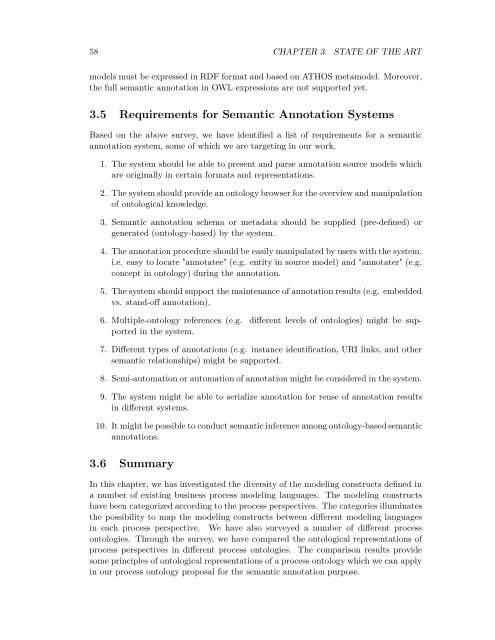Semantic Annotation for Process Models: - Department of Computer ...
Semantic Annotation for Process Models: - Department of Computer ...
Semantic Annotation for Process Models: - Department of Computer ...
Create successful ePaper yourself
Turn your PDF publications into a flip-book with our unique Google optimized e-Paper software.
58 CHAPTER 3. STATE OF THE ART<br />
models must be expressed in RDF <strong>for</strong>mat and based on ATHOS metamodel. Moreover,<br />
the full semantic annotation in OWL expressions are not supported yet.<br />
3.5 Requirements <strong>for</strong> <strong>Semantic</strong> <strong>Annotation</strong> Systems<br />
Based on the above survey, we have identified a list <strong>of</strong> requirements <strong>for</strong> a semantic<br />
annotation system, some <strong>of</strong> which we are targeting in our work.<br />
1. The system should be able to present and parse annotation source models which<br />
are originally in certain <strong>for</strong>mats and representations.<br />
2. The system should provide an ontology browser <strong>for</strong> the overview and manipulation<br />
<strong>of</strong> ontological knowledge.<br />
3. <strong>Semantic</strong> annotation schema or metadata should be supplied (pre-defined) or<br />
generated (ontology-based) by the system.<br />
4. The annotation procedure should be easily manipulated by users with the system,<br />
i.e. easy to locate "annotatee" (e.g. entity in source model) and "annotater" (e.g.<br />
concept in ontology) during the annotation.<br />
5. The system should support the maintenance <strong>of</strong> annotation results (e.g. embedded<br />
vs. stand-<strong>of</strong>f annotation).<br />
6. Multiple-ontology references (e.g. different levels <strong>of</strong> ontologies) might be supported<br />
in the system.<br />
7. Different types <strong>of</strong> annotations (e.g. instance identification, URI links, and other<br />
semantic relationships) might be supported.<br />
8. Semi-automation or automation <strong>of</strong> annotation might be considered in the system.<br />
9. The system might be able to serialize annotation <strong>for</strong> reuse <strong>of</strong> annotation results<br />
in different systems.<br />
10. It might be possible to conduct semantic inference among ontology-based semantic<br />
annotations.<br />
3.6 Summary<br />
In this chapter, we has investigated the diversity <strong>of</strong> the modeling constructs defined in<br />
a number <strong>of</strong> existing business process modeling languages. The modeling constructs<br />
have been categorized according to the process perspectives. The categories illuminates<br />
the possibility to map the modeling constructs between different modeling languages<br />
in each process perspective. We have also surveyed a number <strong>of</strong> different process<br />
ontologies. Through the survey, we have compared the ontological representations <strong>of</strong><br />
process perspectives in different process ontologies. The comparison results provide<br />
some principles <strong>of</strong> ontological representations <strong>of</strong> a process ontology which we can apply<br />
in our process ontology proposal <strong>for</strong> the semantic annotation purpose.
















